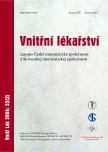The meaning of the combination of fibrinogen, micro/macroalbuminuria and atheromatosis in the carotic bloodstream for the evaluation of the abnormal finding of the stress myocardial SPECT in the asymptomatic 2nd type diabetic patients
Authors:
V. Zamrazil Jr; S. Pálová; D. Holá
Authors‘ workplace:
Interní klinika 2. lékařské fakulty UK a FN Motol, Praha, přednosta doc. MUDr. Milan Kvapil, CSc.
Published in:
Vnitř Lék 2006; 52(2): 119-123
Category:
Original Contributions
Overview
Objectives:
Stress perfusion myocardial scintigraphy (SPECT) is useful in silent ischemia detection in the group of the asymptomatic type 2. diabetic patients. In our paper we present the combinations of the parameters predictive for stress myocardial SPECT result.
Methods:
We selected parameters (fibrinogen, micro/macroalbuminuria, ateroma in carotid artery bed) that were significantly associated with stress myocardial SPECT result. We analyzed the combinations of these parameters change and evaluated their significance for stress myocardial SPECT result prediction.
Results:
We evaluated 121 type 2. diabetic patients without patological ECG changes and with normal left ventricle ejection fraction. Thirty one (26 %) had abnormal and 90 (74 %) equivocal or normal stress myocardial SPECT result. The combination of ateroma presence in carotid bed and fibrinogen in upper tertile was found in 20 patients. Fifteen of them (75 %) had the abnormal SPECT result. The combinations of the ateroma absence, negative micro/macroalbuminuria and fibrinogen in the middle or lower tertile were present almost in the half of all the examined diabetic patients. Such combinations were connected with normal or equivocal SPECT result in 93 - 96 % cases.
Conclusion:
Micro/macroalbuminuria, fibrinogen and ateroma in carotid bed found by sonography are significantly associated with stress myocardial SPECT result. Combinations of these parameters changes lead to the futher stratification that enables the rationale approach in the stress examination indication.
Key words:
type 2 diabetes mellitus - fibrinogen - microalbuminuria - carotis artery sonography - coronary artery disease prediction
Sources
1. Webster MW, Scott RR. What cardiologists need to know about diabetes. Lancet 1997; 350 (Suppl 1): 23-28.
2. Nesto R. Angina and exertional myocardial ischaemia in diabetic and nondiabetic patients. Assesment by exercise thallium scintigraphy. Ann Intern Med 1988; 108: 170-175.
3. Charvát J, Kolbel F, Michalová K et al. Asymptomatická ischemická choroba srdeční u nemocných s diabetes mellitus. DMEV 2004; 7: 109-116.
4. Charvát J, Michalová K, Táborská K et al. Comparison of the exercise ECG and stress myocardial SPECT in detection of the significant coronary artery disease in the asymptomatic patients with diabetes mellitus type 2. Bratisl Lek Listy 2004; 105: 56-61.
5. Charvát J, Michalová K, Táborská K et al. Vztah kompenzace diabetu, přítomnosti albuminurie a některých biochemických parametrů k výsledku zátěžového SPECT-u myokardu u asymptomatických diabetiků 2. typu. Vnitř Lék 2004; 50: 894-900.
6. Charvát J, Michalová K, Táborská K et al. Vztah echokardiografického vyšetření a sonografie karotické tepny k výsledku zátěžového SPECT myokardu u asymptomatických nemocných s diabetes mellitus 2. typu. Cor Vasa 2004; 46: 371-378.
7. Faglia E, Favales F, Calia P et al. Cardiac events in 735 type 2 diabetic patients who underwent screening for unknown asymptomatic coronary heart disease. 5-years follow-up report from Milan Study on Atherosclerosis and Diabetes (MiSAD), Diabetes Care 2002; 25: 2032-2036.
8. Paramo JA, Orbe J, Beloqui O et al. Prothrombin fragment 1+2 is associated with carotid-media thickness in subjects free of clinical cardiovascular disease. Stroke 2004; 35: 1085-1089.
9. Hachamovitch R, Berman S, Kiat H et al. Exercise myocardial perfusion SPECT in patients without known coronary artery disease. Incremental prognostic value and use for stratification. Circulation 1996; 93: 905-914.
10. De Lorenzo A, Lima RS, Siquiera-Filha AG et al. Prevalence and prognostic value of perfusion defects detected by stress technetium-99 sestamibi myocardial perfusion single-photon emission computed tomography in asymptomatic patients with diabetes mellitus and no known coronary artery disease. Am J Cardiol 2002; 90: 827-832.
11. Janand-Delenne B, Savin B, Habib G et al. Silent myocardial ischemia in patients with diabetes: Who to screen. Diabetes Care 199; 22: 1396-1400.
12. Bacci S, Villela M, Villela A et al. Screening of silent myocardial ischaemia in type 2 diabetic patients with additional atherogenic factors: applicability and accuracy of the exercise test. Eur J Endocrinol 2002; 147: 649-654.
13. American Diabetes Association. Consensus development conference on the diagnosis of coronary heart disease in people with diabetes. Diabetes Care 1998; 21: 1551-1559.
14. Cosson E, Attali J, Valensi P. Markers for silent myocardial ischemia in diabetes. Are they helpful? Diabetes Metab 2005; 31: 47-54.
15. Rutter MK, McComb JM, Brady S et al. Silent myocardial ischemia and microalbuminuria in asymptomatic subjects with non-insulin-dependent diabetes mellitus. Am J Cardiol 1999; 83: 27-31.
16. Piot C, Fontbonne A, Sultan A et al. Inflammatory parameters are independent predictors of severe epicardial coronary stenosis in asymptomatic diabetic patients with silent myocardial ischemia. Diabetes Care 2003; 26: 545-546.
17. Streja D, Cressey P, Rabkin SW. Associations between inflammatory markers, traditional risk factors, and complications in patients with type 2 diabetes mellitus. Journal of Diabetes and Its Complications 2003; 17: 120-127.
18. Paramo JA, Beloqui O, Roncal C et al. Validation of plasma fibrinogen as a marker of carotid atherosclerosis in subjects free of clinical cardiovascular disease. Haematologica 2004; 89: 1226-1231.
19. Nossen JM, Vierzigmann T, Lang E. Calcified plaques of extracranial carotid arteries and left ventricular geometry as predictors of coronary artery disease. Med Klin 2003; 98: 72-78.
20. Boucher B, Ceresier A, Bouchou K et al. Silent myocardial ischemia in type 2 diabetes. Predictive value of intima-media thickness. Presse Med 2002; 31: 218-222.
Labels
Diabetology Endocrinology Internal medicineArticle was published in
Internal Medicine

2006 Issue 2
Most read in this issue
- Idiopathic premature ventricular complexes - catheter ablation as a therapeutic alternative
- The role of transesophageal echocardiopgraphy in detection of cardiogenic and aortic sources of embolism in stroke and transient ischaemic attacks
- Can we cure atrial flutter with radiofrequency ablation in an hour?
- Osteonecrosis of the jaw in the course of multiple myeloma treatment and bisphosphonate administration
